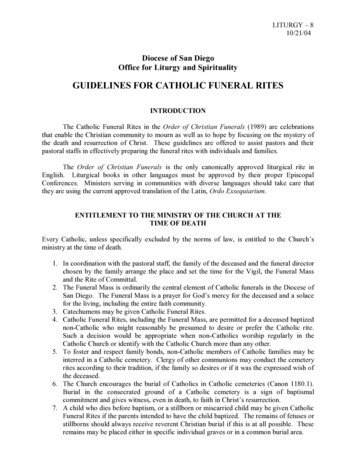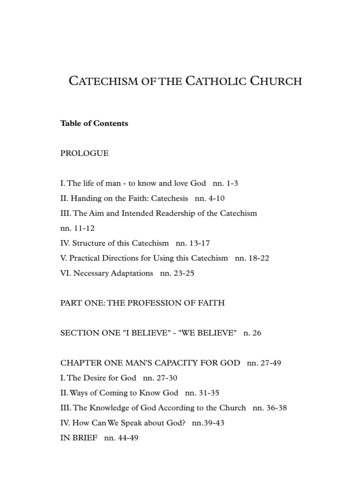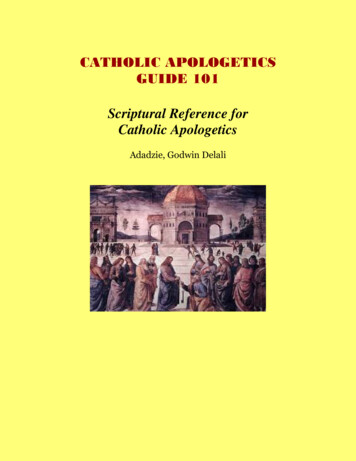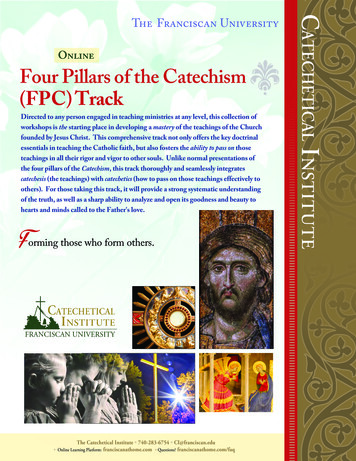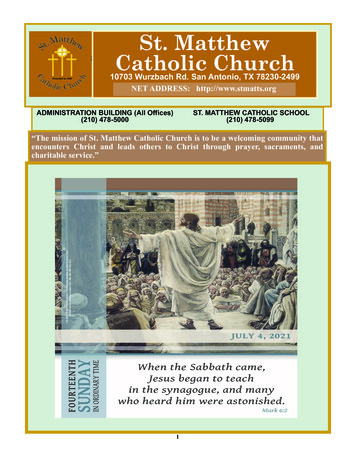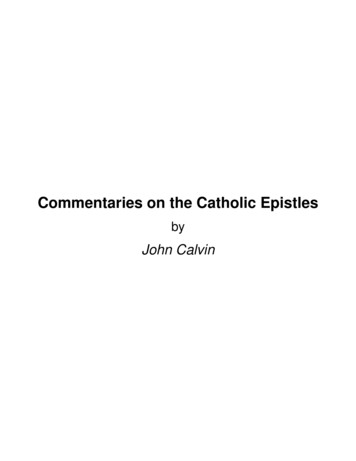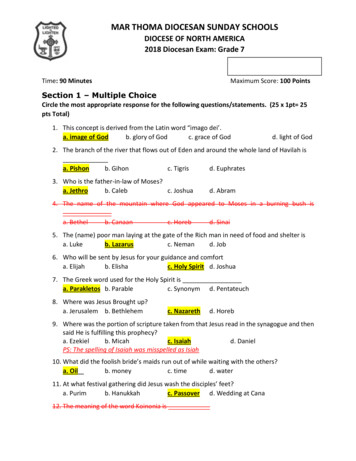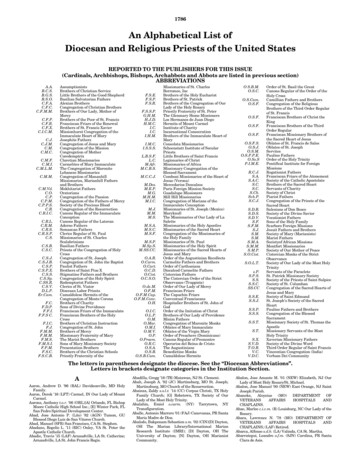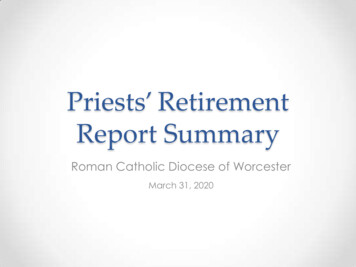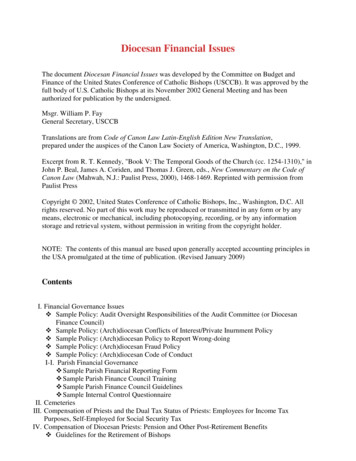
Transcription
Diocesan Financial IssuesThe document Diocesan Financial Issues was developed by the Committee on Budget andFinance of the United States Conference of Catholic Bishops (USCCB). It was approved by thefull body of U.S. Catholic Bishops at its November 2002 General Meeting and has beenauthorized for publication by the undersigned.Msgr. William P. FayGeneral Secretary, USCCBTranslations are from Code of Canon Law Latin-English Edition New Translation,prepared under the auspices of the Canon Law Society of America, Washington, D.C., 1999.Excerpt from R. T. Kennedy, "Book V: The Temporal Goods of the Church (cc. 1254-1310)," inJohn P. Beal, James A. Coriden, and Thomas J. Green, eds., New Commentary on the Code ofCanon Law (Mahwah, N.J.: Paulist Press, 2000), 1468-1469. Reprinted with permission fromPaulist PressCopyright 2002, United States Conference of Catholic Bishops, Inc., Washington, D.C. Allrights reserved. No part of this work may be reproduced or transmitted in any form or by anymeans, electronic or mechanical, including photocopying, recording, or by any informationstorage and retrieval system, without permission in writing from the copyright holder.NOTE: The contents of this manual are based upon generally accepted accounting principles inthe USA promulgated at the time of publication. (Revised January 2009)ContentsI. Financial Governance Issues Sample Policy: Audit Oversight Responsibilities of the Audit Committee (or DiocesanFinance Council) Sample Policy: (Arch)diocesan Conflicts of Interest/Private Inurnment Policy Sample Policy: (Arch)diocesan Policy to Report Wrong-doing Sample Policy: (Arch)diocesan Fraud Policy Sample Policy: (Arch)diocesan Code of ConductI-I. Parish Financial Governance Sample Parish Financial Reporting Form Sample Parish Finance Council Training Sample Parish Finance Council Guidelines Sample Internal Control QuestionnaireII. CemeteriesIII. Compensation of Priests and the Dual Tax Status of Priests: Employees for Income TaxPurposes, Self-Employed for Social Security TaxIV. Compensation of Diocesan Priests: Pension and Other Post-Retirement Benefits Guidelines for the Retirement of Bishops
V. Compensation of Religious Medicare as Secondary PayerVI. Compensation of Lay Employees and Deacons of the ChurchVII. Deposit and Loan FundsVIII. Diocesan Finance Councils Sample Diocesan Finance Council Statutes Diocesan Financial Reporting – USCCB Resolution Sample Diocesan Financial Reporting FormIX. Diocesan Finance OfficerX. Federal FundingXI. Foundations & EndowmentsXII. Fundraising, Diocesan Appeals and Gift AcceptanceXIII. Income TaxXIV. InvestmentsXV. Property and EquipmentXVI. Records RetentionXVII. Service FundsXVIII. School Tuition vs. DonationXIX. Special CollectionsAppendicesA. Financial Statements and Notes—SamplesB. Resources
ForewordIn April 1971, the United States Catholic Conference (USCC; now the United States Conferenceof Catholic Bishops [USCCB]) published Diocesan Accounting and Financial Reporting. Thismanual resulted from the work of an Ad Hoc Committee on Diocesan Financial Statements withthe assistance of one of the then-"Big 8" accounting firms.In 1981—after ten years of experience with the original manual, coupled with developments inthe accounting profession (especially SOP 78-10) and the recommendation of the DiocesanFiscal Management Conference (DFMC)—the need for a revision of this landmark documentwas clearly evident. This task was undertaken by the Accounting Practices Committee (APC) ofthe USCCB. The committee's work was aided by advisors from six public accounting firms andinput from dioceses across the country. The revision consisted of the preparation of acceptableaccounting principles and reporting practices for external financial reports. Titled AccountingPrinciples and Reporting Practices for Churches and Church-Related Organizations, therevision was approved at the November 1981 General Meeting of the U.S. Catholic bishops;subsequently three appendices, including illustrative financial statements, were prepared andreleased by the APC.While the development of generally accepted accounting principles (GAAP) in the not-for-profitsector has traditionally been slower than in the commercial sector, this situation has changeddramatically since the last rewrite of the USCCB accounting manual. For example, in 1993, theFinancial Accounting Standards Board (FASB) issued two Statements of Financial AccountingStandards (SFAS) that represented significant changes in accounting and reporting for not-forprofits entities: SFAS No. 116—Accounting for Contributions Received and Contributions MadeSFAS No. 117—Financial Statements of Not-For-Profit OrganizationsThese two FASB Statements established standards applicable to all not-for-profit organizations,with the consequence that provisions in AICPA Guides and Statements of Position that areinconsistent with these standards were no longer acceptable specialized accounting and reportingprinciples and practices. As significant as these two statements were to not-for-profits, the FASBhas not slowed the pace of change, and the complexity of accounting principles and reportingpractices has increased significantly. Today more than one hundred pronouncements defineGAAP for not-for-profit organizations. Generally accepted auditing standards (GAAS) have alsobeen radically changed by the Office of Management and Budget's issuance of Circular A-133,which impacts virtually every social service program sponsored by the Catholic Church in theUnited States today.With this background, it was apparent that Accounting Principles and Reporting Practices forChurches and Church-Related Organizations was out of date and provided little, if any,guidance to those it was intended to serve. Couple this with demands from donors for increasedaccountability and increased scrutiny from government entities, and a major rewrite of thismanual was not only obviously necessary but also long overdue. This monumental task was onceagain given to the APC.
After a thorough study and review, the APC has recommended the use of PractitionersPublishing Company's Guide to Preparing Nonprofit Financial Statements (PPC) as areplacement for the outdated manual. Therefore, the PPC will provide general accountingguidance for the Catholic Church in the United States. However, due to the unique nature ofvarious church financial accounting and reporting issues, the APC has prepared this companionmanual to the PPC. The companion manual is intended to offer additional guidance to diocesesconcerning these unique issues that are not covered in the PPC manual.Finally, I offer my deep gratitude and profound appreciation as well as that of my brotherbishops to the APC for their professionalism, time, and talent in completing this most importantproject.Most Reverend Henry J. MansellBishop of BuffaloTreasurer, USCCBNOTE: To obtain PPC publications, call (800)323-8724 or go to www.ppcnet.com.
USCCB Accounting Practices CommitteeMEMBERSMr. William G. Weldon, CPA, ChairpersonDiocese of CharlotteRev. Henry T. Chamberlain, SJ, MBAGeneral Curia, Society of JesusMr. Guy Chapdelaine, CPADiocese of ManchesterDeacon C. Frank Chauvin, CPAArchdiocese of St. LouisSr. M. Diane Cook, OSB, CPABenedictine Sisters of Erie, Inc.Rev. Albert J. DiUlio, SJUSA Jesuit ConferenceMr. David A. HoldenArchdiocese of DenverMr. Joseph E. Ingraham, CPADiocese of Baton RougeMs. Mary Beth Koenig, CPADiocese of AustinSr. Frances Mlocek, IHM, CPASister, Servants of the Immaculate Heart of MaryMr. Philip J. Ries, CPADiocese of OrangeMr. Robert M. Sellers, Jr. CPADiocese of BirminghamMr. Paul A. Ward Jr., CPADiocese of St. PetersburgMr. Michael T. Weis, CPADiocese of DallasSTAFFMr. Bruce EgnewAssociate General SecretaryADVISORSMs. Ellen Harrison, CPAKPMG LLPMr. Frank L. Kurre, CPAGrant Thornton, LLPMr. Scott D. Steffens, CPADeloitte & Touche
I. Financial Governance Issues1. IntroductionThe Church is responsible for the financial resources which have been entrusted to it. Thisresponsibility includes safeguarding Church assets, exercising prudence in financial matters,accountability to those who provide monetary support to the Church and to regulatoryauthorities, and compliance with all civil regulations. As such, the Church is committed to thehighest standards of fiscal integrity and accountability. Strong systems of internal controls areneeded to safeguard assets by reducing the risk of fraud, misuse, waste or embezzlement. It isimportant that all diocesan officials and all employees within a diocese be sure that best financialpractices are being followed. Best financial practices dictate that diocesan organizations reviewtheir policies and procedures in light of the continuing developments and those recentdevelopments outlined below.The American Competitiveness and Corporate Accountability Act of 2002, commonly know asthe Sarbanes-Oxley Act, was enacted in response to several corporate and accounting scandalsthat occurred in 2001 and 2002. Its purpose is to rebuild trust in America’s corporate sector andpromote stability in the financial markets. The law pertains primarily to public companies andaddresses auditor independence, corporate responsibility for financial reports and internalcontrols, and governance issues. Certain provisions of Sarbanes-Oxley apply to allorganizations, including not-for-profits, because of preexisting law. The record retentionprovision and the whistle blower protection provisions apply to not-for-profit organizations,including churches. However, it behooves the Church to consider all of the Act’s provisions indeveloping best financial practices.Not-for-profit organizations are fast becoming the focus of similar oversight measures. Forexample, California passed the Nonprofit Integrity Act of 2004 which addresses two broad areasof nonprofit activity: governance and fundraising. While religious organizations are exemptfrom most of the provisions of this law, they are subject to its fundraising and compensationreview provisions.The Senate Finance Committee has been considering a host of recommendations intended tostrengthen the not-for-profit sector’s transparency, governance and accountability. IndependentSector, www.independentsector.org, a leadership forum for charities, provides information onproposals being considered by policymakers that will affect not-for-profits. The Panel on theNonprofit Sector, which was convened by Independent Sector, issued Principles for GoodGovernance and Ethical Practice – A Guide for Charities and Foundations in October 2007.The document is available at s Guide.pdf.The remainder of this chapter addresses several financial governance issues that are offered asadvice to diocesan bishops to be used in their dioceses as they deem appropriate.I-1
2. Internal ControlsThe Committee on Budget and Finance of the United States Conference of Catholic Bishops(USCCB) has published a framework titled Diocesan Internal Controls. This twenty-eight-pagebooklet includes chapters on the following topics: Internal Control: A DefinitionInternal Control: Relationships and ResponsibilitiesEstablishing Internal Controls: Specific Practices, Procedures, and TechniquesGuidelines for a Diocesan Internal Controls ReviewFraud and Irregularities: Concepts, Examples, and Detection RulesA copy of the book can be obtained on line at http://www.usccb.org/finance/internal.shtml.3. Fraud Prevention Programs and ControlsGuidance to help prevent and deter fraud can be found in Management Antifraud Programs andControls (an exhibit to SAS No. 99). This document was commissioned by the Fraud Task Forceof the American Institute of Certified Public Accountants’ (AICPA) Auditing Standards Boardand has been issued to provide guidance to boards of directors, audit committees andmanagement to prevent and deter fraud. It discusses how to evaluate the risks of fraud as well asimplement the processes, procedures and controls needed to reduce fraud.This 22 page document can be obtained at: http://antifraud.aicpa, then do a search on “SAS No.99”, and click on “Download the exhibit.” Its outline is: IntroductionCreating a Culture of Honesty and High EthicsEvaluating Antifraud Processes and ControlsDeveloping an Appropriate Oversight ProcessOther Information – Sample Code of Conduct, Code of Ethics4. Communications of Internal Control Related Matters Noted in an AuditStatement on Auditing Standards (SAS) No. 112, Communicating Internal Control RelatedMatters Identified in an Audit establishes standards and provides guidance for auditors oncommunicating matters related to an entity’s internal control over financial reporting identifiedin an audit of financial statements. It is applicable whenever an auditor expresses an opinion onfinancial statements (including a disclaimer of opinion).In particular, this SAS: defines the terms "significant deficiency" and "material weakness"; provides guidance on evaluating the severity of control deficiencies identified in an auditof financial statements; and requires the auditor to communicate, in writing, to management and those charged withgovernance, significant deficiencies and material weaknesses identified in an audit.I-2
The GAO's Government Auditing Standards, July 2007 Revision has updated GovernmentAuditing Standard’s internal control terminology to be consistent with SAS 112. As such, thesedefinitions will be applied by auditors in A133 audits as well. .5. Audit CommitteeEach diocese should consider adopting the oversight functions provided by an audit committee.An independent audit committee should be established, or those responsibilities should beassigned to the diocesan finance council, if the finance council consists primarily of persons whoare not diocesan officials. An audit committee’s primary functions include oversight of theinternal control structure, evaluating the independent auditors, discussing the audit results withthe independent auditors, overseeing the whistle blower and fraud policies, providing guidance inthe prevention and reporting of fraud and reviewing compliance with the Code of Conduct.Members of the audit committee should have the necessary professional and technicalbackground to deal with accounting and internal control matters.The AICPA Audit Committee Toolkit: Not-for-Profit Organizations is a valuable tool for auditcommittees to perform their oversight function effectively and efficiently. The AICPA permitsorganizations to download the tools and tailor or customize them for internal use at no cost. Thelink to the AICPA toolkit is ge.htmEach Diocese should consider having an “audit committee financial expert” on its AuditCommittee or Finance Council. For public companies, the SEC defines such a person as havingthe following attributes:1. An understanding of generally accepted accounting principles and financialstatements;2. The ability to assess the general application of such principles in connection withthe accounting for estimates, accruals and reserves;3. Experience preparing, auditing, analyzing or evaluating financial statements thatpresent a breadth and level of complexity of accounting issues that are generallycomparable to the breadth and complexity of issues that can reasonably beexpected to be raised by the diocese’s financial statements, or experience activelysupervising one or more persons engaged in such activities;4. An understanding of internal controls and procedures for financial reporting; and5. An understanding of audit committee functions.The need for qualified people on audit committees at a diocese is just as important as it is for apublic company.A sample charter addressing the Audit Oversight Responsibilities of the Audit Committee (orDiocesan Finance Council) is attached to this chapter as Exhibit I-A.I-3
6. Conflict of Interest PolicyEach Diocese should establish a conflict of interest policy. Although such a policy cannotprevent illegal or unethical behavior, it will help establish and create a proper controlenvironment. The following items should be considered when developing a conflict of interestpolicy. It should be decided who is to monitor and ensure compliance with the conflict ofinterest policy. It should also be decided which personnel are required to provide awritten acknowledgement of compliance with the conflict of interest policy anddisclose all potential conflicts of interest. Dealings with the diocese that appear to have dual interests or a conflict of interestshould be evaluated closely (e.g., transactions with entities in which a diocesanemployee or volunteer has a direct or indirect financial interest, or support beingprovided to other organizations with which an employee or volunteer is directlyassociated). Whether a matter is of significant importance to constitute a conflict of interestshould be determined by the bishop or his designee (e.g. legal counsel).An example of a policy statement is attached as Exhibit I–B.7. Policy to Report Wrong-doingA strong preventive and detective measure against fraud in any organization is the opportunityfor employees and other constituents to anonymously report suspected wrongdoing(whistleblowing) without the threat of retaliation. Each diocese should consider adopting apolicy to report wrong-doing (commonly referred to as a whistleblower policy) and developingprocedures to address “whistleblower” complaints regarding ethics, integrity, internal controls,and accounting or auditing matters. A sample policy to report wrong-doing is attached to thischapter as Exhibit I-C.8. Fraud PolicyEach diocese should have a fraud policy that is clear, concise and documented. As such, eachdiocese should consider drafting a written fraud policy. The policy should state that fraud is nottolerated and stipulate that the consequences of participating in fraudulent acts include, but arenot limited to, termination, and civil and criminal prosecution. It should also define fraudulentactions and address how to report suspected cases of fraud. A sample fraud policy is attached tothis chapter as Exhibit I-D.9. Records Retention PolicyEach diocese should have a records retention policy and procedures. See chapter XVI foradditional information on record retention guidelines.I-4
10. Code of ConductEach diocese should consider establishing a written Code of Conduct and promulgating it to thepeople of the Diocese. A Code of Conduct memorializes in a clear and distinct mannerappropriate behavior and practices that will be followed by all clergy, religious, lay employeesand volunteers. A sample Code of Conduct is attached to this chapter as Exhibit I-E.I-5
Exhibit I - AThe (Arch)diocese Of XxxAudit Oversight Responsibilities of the Audit Committee (or Diocesan Finance Council)SummaryThe (Arch)diocesan Finance Council has a responsibility to oversee the financial reportingprocess of (Arch)diocesan entities and to advise the (Arch)bishop in matters pertaining tofinancial reporting and the annual financial audit.However, it is not the responsibility of the (Arch)diocesan Finance Council to provide expertassurance regarding the financial statements or the annual financial audit. Furthermore,diocesan officials are responsible for the preparation of the financial statements, for the fairpresentation in the financial statements of the entities’ financial position, results of its activitiesand cash flows in conformity with accounting principles generally accepted in the United States,and for the design and implementation of its systems of internal accounting control.Furthermore, the (Arch)diocesan Finance Council is advisory to the (Arch)bishop, in mostmatters (see Chapter VIII), and discharges its duty by (1) acting in good faith; (2) utilizing thecare that an ordinary prudent person in a like position would exercise under similar conditions;and (3) acting in a manner that they reasonably believe to be in the best interests of the(Arch)diocese.The inquiries, discussions and reviews required in the following key responsibilities are to beperformed by the (Arch)diocesan Finance Council or may be wholly or partially performed by an(Arch)diocesan Audit Committee. However, if any such matters are assigned to an AuditCommittee, the Finance Council should require the Audit Committee to report fully allsignificant matters or findings to the Finance Council.Key ResponsibilitiesSystems of Internal Accounting Controls1) Inquire whether diocesan officials are setting the appropriate tone by communicating theimportance of internal controls so that all individuals possess an understanding of their rolesand responsibilities.2) Inquire whether diocesan officials are using independent firms to review computer systemsand applications, the security of such systems and applications, and the contingency plan forprocessing financial information in the event of a systems breakdown.3) Discuss with the independent auditors any internal control recommendations made during thecourse of their audit and inquire from both the outside auditors and diocesan officials as towhether internal control recommendations identified by the independent auditors have beenimplemented.I-6
4) Inquire of the independent auditors, diocesan officials and legal counsel about any suspectedor confirmed fraud, illegal acts, or deficiencies in internal controls.5) Regarding complaints pertaining to accounting and auditing matters:a) Inquire whether procedures have been established for the confidential, anonymoussubmission by employees of concerns regarding questionable accounting and auditingmatters; andb) Review the receipt and treatment of complaints received regarding accounting or auditingmatters that were submitted by any party, internal or external to the organization.Compliance with laws and regulations1) Review the findings of any examinations by regulatory agencies.2) Review with counsel any legal matters that could have a significant impact on the financialstatements.Compliance with Code of Conduct and other governance policies1) Ensure that a policy addressing ethical conduct is formalized in writing and that it iscommunicated to all employees and volunteers.2) Ensure that whistleblower and fraud policies are formalized in writing and that they arecommunicated to all employees and volunteers.3) Periodically obtain updates from management and general counsel regarding compliancewith the code of conduct.4) Periodically obtain the results of all reported fraud and whistleblower investigations.5) Inquire whether conflict of interest forms have been received from appropriate officials andreviewed for conflict issues.Financial Reporting1) Before the audited financial statements are issued to the public, meet with diocesan officialsand the independent auditors to review the annual financial statements and the results of theaudit. This meeting should take place not later than four months after the end of the fiscalyear. Ask diocesan officials and the independent auditors about significant risks andexposures, the accounting and disclosure of these risks and exposures in the annual financialstatements, and plans to minimize such risks in the future. Also, ask the auditors theirassessment of the quality of accounting principles, the degree of conservatism oraggressiveness of estimates and about other significant judgments made by diocesan officialsin preparing the financial statements and disclosures. Ask the independent auditors to reporton and to discuss the following:a) All changes to significant accounting policies and practices used by the diocese; includingcritical accounting estimates, and how current and anticipated future events impact thosedeterminations;I-7
b) All changes in alternative treatments (accounting and disclosure) of financial informationwithin generally accepted accounting principles for policies and practices related tomaterial items that have been discussed with diocesan officials, including theramifications of the use of such alternatives and the treatment preferred by the auditors;andc) Other material written communications between the auditors and diocesan officials. Thefollowing are examples, not all-inclusive, of written communications that should bereviewed:i) Schedules of material unadjusted differences and a listing of material adjustments andreclassifications not recorded, if any, for all entities;ii) Diocesan managements’ representation letter for the audit of the financial statements;iii) Reports on observations and recommendations on internal controls;iv)The engagement letter for the audit of the financial statements;v) The audit firm’s independence in relation to all (arch)diocesan entities; andvi)The final billing for services rendered, if different than the pre-approved amount.Independent Auditors1) Recommend to the (Arch)bishop the appointment or discharge of the independent auditors.2) Recommend all audit, review and attest services, all agreed-upon procedures, and all otherservices to be performed for all diocesan entities by the independent auditors.3) Review and confirm the independence of the independent auditors by:a. Reviewing the nonaudit services performed by the auditors, andb. Reviewing the auditors’ lead and concurring audit partners' rotation schedules.4) Approve the independent auditors’ fees.Other Matters1) Meet with the independent auditors and diocesan officials in separate executive sessions todiscuss any matters that the Audit Committee/Finance Council believe should be discussedprivately.2) Ensure that significant findings by the independent auditors are received and addressed on atimely basis.3) If necessary, recommend to the (Arch)bishop that he institute special investigations and, ifappropriate, hire special counsel or experts.I-8
4). Advise the (Arch)diocese concerning the possible hiring a member of the audit engagementteam for a financial reporting oversight position in the diocese.5). Annually review and update this document, as needed.I-9
Exhibit I - B(Arch)diocese of Xxx Conflicts of Interest/Private Inurnments PolicyPurposeThe purpose of this conflicts of interest and private inurnment policy is to protect the(Arch)diocese's interest when it is contemplating entering into a transaction or arrangement thatmight benefit the interests of private individuals, including but not limited to employees andindividuals performing work on behalf of the (Arch)diocese and other persons in a position toinfluence the affairs of the (Arch)diocese. This policy is intended to supplement but not replaceany applicable state laws governing conflicts of interest applicable to non-profit and charitablecorporations. This policy should be distributed to existing and future executives, officers,trustees, directors, and members of advisory boards, councils and committees.IntroductionNon-profit charitable, religious, and educational organizations obtain their tax-exempt statusunder the theory that they perform valuable services for society and lessen the burdens ofgovernment. If a tax-exempt organization allows its money or other property to be used forprivate rather than public gain (i.e., for "private inurnment" or "private benefit"), then it riskslosing its exemption. In addition, under recently adopted "intermediate sanctions" provisions ofthe Internal Revenue Code, "disqualified persons" such as (Arch)bishops, CFOs, other(Arch)diocesan officials, board members, major donors doing work for the (Arch)diocese, etc.,who receive "excess benefits" are subject to an excise tax ranging from 25% to 200%, dependingon the circumstances. Furthermore, any organizational manager who knowingly facilitates suchan excess benefit is subject to a 10% tax. In light of these IRS restrictions and, more importantly,in order to assist the (Arch)diocese in fulfilling its responsibilities to act as a competent andtrustworthy steward of church goods, the (Arch)diocese has developed this policy.Identifying a Private Inurnment or Private Benefit ProblemIn brief, "private inurnment" is the payment or diversion of an exempt organization's assets to itsofficials, officers, directors, employees, relatives, friends, major donors, or others in a specialrelationship to the organization who can influence or control the policy or the day-to-dayactivities of the organization for less than full and adequate consideration. It is a broad conceptthat can exist in a variety of transactions under a variety of circumstances. Private inurnment alsoextends to the use of organizational assets for "private benefits" such as sales, leasing,construction contracts, service transactions, etc., at other than fair market value or theexploitation of the exempt organization for the benefit of a private business (e.g., "sweetheartdeals," promotional schemes, and/or giveaways to private individuals or businesses). Thus, underIRS regulations, a private benefit is similar to, but broader than, private inurnment.To avoid a material private inurnment or benefit in the types of transactions described above, theparticular (Arch)diocesan parish, school, or agency must enter into transactions for its benefit,rather than for a private party's benefit, and exercise due diligence to ensure that the proposedtransaction is fair and reasonable such that under the circumstances the organization could nothave obtained a more advantageous arrangement with reasonable effort. In addition to screeningproposed transactions through the applicable councils, boards, or trustees, care should be taken tofollow (Arch)diocesan policies and procedures pertaining to the signing of contracts.I-10
Conflicts of InterestA conflict of interest may exist when persons employed by the "(Arch)diocese" (i.e., the CentralAdministrative Office, parishes, schools, (Arch)diocesan agencies, and/or affiliated ent
Sample Diocesan Financial Reporting Form IX. Diocesan Finance Officer X. Federal Funding . (especially SOP 78-10) and the recommendation of the Diocesan Fiscal Management Conference (DFMC)—the need for a revision of this landmark document . MBA General Curia, Society of Jesus Mr. Guy Chapdelaine, CPA Diocese of Manchester Deacon C. Frank .
